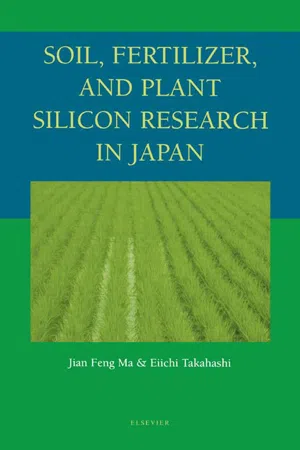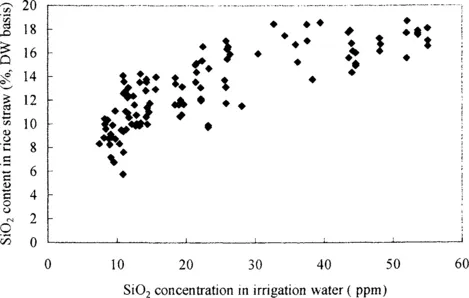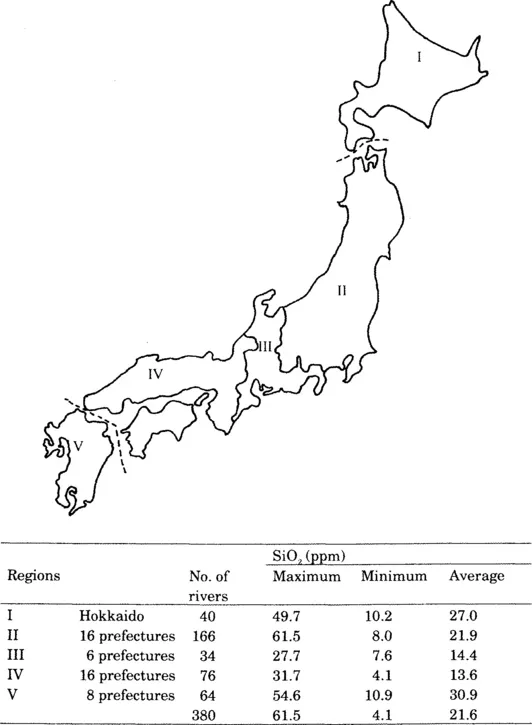![]()
Chapter 1
Brief history of silicon research in Japan—Birth of silicate fertilizer
Silicon (Si) is the second most abundant element, both in terms of weight and number of atoms, in the earth’s crust. Because of its strong affinity with oxygen, Si in nature always exists as silica (Si dioxide) or silicates, which are combined with various metals. Silicon dioxide comprises about 60% of the earth’s crust, and it occupies more than 50% of the soil and the concentration of Si in soil solution in the form of silicic acid is between 3.5 and 40 mg Si L−1 (Marschner 1995). Therefore, all plants rooting in soil contain Si in their tissues. However, because of its universal existence, researchers did not pay much attention to the impact of Si on plant growth. In his article on Si nutrition, Sachs (1862) first asked “whether silicic acid is an indispensable substance for those plants that contain silica, whether it takes part in nutritional processes, and what is the relationship that exists between silicic acid and the life of the plant.” However, Sachs concluded that Si was insignificant for the nutritional process of maize when he found that water-cultured maize which contained 0.3% Si did not show any abnormality in growth compared with maize containing 9% Si. Since then many studies have been carried out on the effect of Si on plant growth.
In Japan, Si research started at the beginning of the twentieth century. In 1917, Onodera reported that the Si content of rice leaves infected with blast disease was lower than that of healthy leaves. This is the first report on Si research published in a scientific journal of agronomy. Later, several papers on the relationship between Si and blast disease were published. For example, it was found that blast disease-resistant cultivars contain a larger amount of Si than blast-sensitive cultivars (Miyake et al., 1922) and application of silicate increased the resistance of rice to blast disease (Kawashima, 1927; Miyake et al., 1932).
Researches on the physiological role of Si in rice were initiated by Ohkawa (1936-1942) and Ishibashi (1936-1939). They found that Si deficiency inhibits the growth of rice, especially the increase in empty grains significantly reduced the yield. They also found that the effect of Si application was more obvious under heavy application of nitrogen fertilizers and that the damage due to brown spot and blast was alleviated by Si application.
Thus it became clear in the late 1930s that Si is important for healthy growth and high grain yield of rice, but the results of these laboratory researches were not applied to the field. Because the Si abundantly present in the soil is gradually solubilized with weathering and Si could also be supplied from irrigation water and compost, it was considered that addition of Si to soil was unnecessary. In addition, appropriate Si fertilizers were not available at that time.
However, from the field trials of akiochi (autumn decline rice growth which happened in degraded paddy soils) in the 1940s, it was recognized that Si in the soil was not sufficient for the healthy growth of rice (Mitsui et al., 1948; Hashimoto et al., 1948).
Rice is the most important crop in Japan where it has been cultivated successively on submerged soil for some 1700 years. Rice cultivation is characterized by continuous cropping without any injury. This cultivation system is different from that of Europe, where the main crops are upland winter cereals. The continuous cropping system suits Japan where only a little arable land is available per person. Paddy field, a special cultivation environment makes continuous cropping of rice possible (upland rice can not be cultivated continuously).
Compared with upland field, paddy field gets lots of irrigation water. The total amount of irrigation water during the rice growth period reaches 14 thousands tons per hectare. Some of the water evaporates from the leaves and surface of paddy fields, and the remaining water is percolated through the soil leaching its soluble components. During the waterlogging period, paddy soil is always washed with water, resulting in leaching of both toxic compounds and nutrient bases such as Ca, K and Mg.
In addition, because the soil surface is covered with water and subsequently shut off from air, the oxygen in soil is consumed and the soil condition becomes strongly reductive. The iron in soil is then reduced and subsequently solubilized, resulting in eluviation of Fe to subsoil. Similarly Mn and Si are also eluviated. Sulfate ion in soil is also reduced to H2S, which is converted to non-toxic FeS with Fe, but when there is not enough active Fe the rice roots will be damaged by H2S.
In degraded paddy soils nutrients such as the bases, Fe, Mn, and Si are leached out and rice roots can be seriously damaged by H2S. In these soils, “akiochi” of rice easily happens. “Akiochi” is a phenomenon in which the growth of rice is good until the end of summer, but thereafter the lower leaves become wilty and brown spots occur, finally resulting in low yield. Such paddy soil can also be used for continuous cropping, but the productivity decreases year after year.
At the time of food shortage after the Second World War, it was an important project to improve degraded paddy soils and therefore many field trials were conducted. The results indicated that supplement of Si in addition to bases and Fe is also important for the improvement of the productivity in declined paddy soils. On the other hand, it was found that slag (calcium silicate as a major component), a by-product from the iron industry that was developing rapidly, could be used as a potential silicate fertilizer. In 1952, the Ministry of Agriculture, Forestry and Fisheries of Japan therefore started field trials on slag at nationwide agricultural experiment stations.
The results of these trials revealed the beneficial effects of slag at various places and in 1955 the Ministry of Agriculture, Forestry and Fisheries decided to put Si on the fertilizer list. Slag that contains a sufficient amount of Si available to the plant, but free of toxic components was recognized as “silicate fertilizers” and the standard of silicate fertilizer was decided. Slag is also utilized in European and American countries, but it was used as lime materials. Japan is the first country to use slag as a Si source for crops.
Silicate fertilizer was born in Japan for the following reasons
1. Rice, the most important crop in Japan, is characterized by high accumulation of Si in the plant;
2. In Japan, rice is usually cultivated at a high density with heavy application of nitrogen fertilizer;
3. Si-deficient soils such as degraded paddy soils are widely distributed;
4. Cheaper silicate fertilizers like slag are provided from iron industry; and
5. Return of the main Si source rice straw to the paddy soil is a gradually decreasing practice mainly because of labor shortage.
The birth of silicate fertilizers is closely linked with this specific nature of Japanese agriculture.
Research on Si has been actively conducted in various areas such as soil, fertilizers and plant science, as will be detailed in each chapter.
![]()
Chapter 2
Silicon sources for agriculture
2.1. SILICON SUPPLY FOR PADDY RICE FROM NATURAL SOURCES
Natural sources of Si for rice are irrigation water and soil. The amount of Si supplied varies with the parent material and geology of river basin.
2.1.1. Irrigation water
Paddy soil is irrigated with an average of 14,000 tons of water per hectare during the growth period of rice. Therefore, Si in irrigation water has an important impact on rice production. Kobayashi (1954) collected 116 samples of rice straw from various places in Japan and found a positive relationship between Si concentration in rice straw and in irrigation water (Figure 2.1).
Figure 2.1 The relationship between Si concentration in irrigation water and Si content in rice straw.
He also collected river water used for irrigation and measured its Si concentration by a colorimetric method (Kobayashi, 1961). As shown in Figure 2.2, among 380 rivers investigated, the lowest concentration of SiO2 was 4.1ppm, and the highest was 61.5 ppm with an average of 21.6 ppm (for details, refer to Appendix I). If rice is irrigated with 14,000 tons water per hectare, it is calculated that an average of 300 kg SiO2 per hectare is supplied to rice from irrigation water annually.
Figure 2.2 Average SiO2 concentration of river waters in five regions of Japan.
In Figure 2.2, the rivers in I, II and V regions have a high Si concentration. This is related to existence of volcanoes in these areas. The Si concentration of river water also varies with geology of basin. River water originating from aqueous rock and granite usually has a low Si concentration, while that from volcanic ash has a high Si concentration (Table 2.1).
Table 2.1
The effect of geology of basin on SiO2 concentration in river water
| Geology of basin | Number of rivers | SiO2 concentrations (ppm) |
| Paleozic (aqueous rock) | 5 | 12.5 | ...


